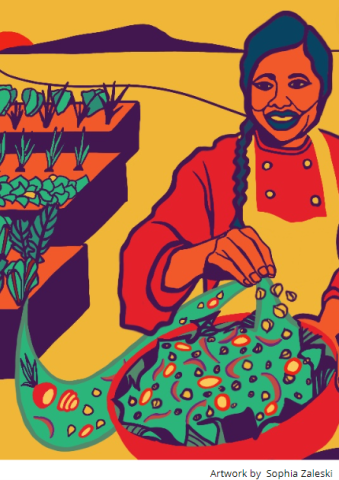Suzy is Food Shift’s Advisory Board Member and Emeritus Culinary Director. Described as the “soul” of Food Shift, Suzy is not only an amazing chef but also an amazing human.
“My mama, Lupita, always made the most delicious vegetable soups when I was growing up. It was a great way to use up any vegetables. The feeling of soup is incredibly comforting and goes beyond just filling your stomach—you feel it in your soul.
Lupita is an amazing cook. All my family knows it. People would show up, and she would cook for them. She always had some food in the pot, going on the stove. It’s one of those things that I remember vividly. She would throw whatever veggies were around in the soup, and every variation tasted so good. It always came at the perfect moment.
Her soups were so yummy, nutrient-dense, and rich, filling a little gap that not all food fills. This soup feeds you, and it gives you a calming feeling all over. When I was really sick, my mom would give me this soup. I would eat it and get a really warm, healing feeling all over my body. It’s making my fingers tingle now. It really healed me on more than just one level—in addition to being nutrient-dense, it soothed my soul, healing my fear and uncertainty. When you’re sick and ask yourself, ‘When is this going to end?’ this soup gives you a little glimpse of feeling like yourself again. It takes that uneasiness away. Just for a moment, you have that bowl. It’s everything your body is craving. It settles you, relaxes you, grounds you. She shared this soup with me; now I’m sharing it with you.
Lupita’s Soup for the Soul
Serves 4
INGREDIENTS:
- 2 medium tomatoes, roughly chopped; or 2 Tbsp tomato paste mixed with 3 Tbsp water; or 1 - 15 oz can of tomatoes
- 1 onion, peeled and roughly chopped
- 2 garlic cloves, peeled and finely chopped; or ½ tsp garlic powder
- Optional: 1 jalapeño, top removed and cut in half lengthwise, seeds and inner membrane removed; and/or 1 tsp cumin
- 4 cups liquid (vegetable broth, bouillon broth or water)
- 1 ½ Tbsp oil
- 6 cups fresh vegetables* (any raw mix), cut similarly (Suzy’s family used carrots chopped small, cubed potatoes, zucchini cut in quarters, and green beans cut into 2-inch pieces (but use whatever vegetables you have))
- Salt and pepper to taste
- Finishing Options: lemon or lime juice; croutons; and/or mushroom bacon
INSTRUCTIONS:
- Puree tomato, onion, garlic, and a pinch of salt with ½ cup broth or water and optional jalapeño and/or cumin, with a food processor or hand blender.
- Heat a medium pot over medium-high heat. Add oil and let warm in the pot, then stir in tomato puree. Let simmer for 10 minutes.
- Add in chopped carrots, potato (or the slower cooking vegetables of your choice), and the remaining 3½ cups vegetable broth and a pinch of salt. Bring to a boil and let cook for 5–8 minutes, until vegetables have started to soften.
- Lower heat to medium low. Add the faster cooking vegetables, like green beans and zucchini. Simmer for 5 minutes until vegetables are tender then remove from the heat. Add salt and pepper to taste and optional lemon or lime juice. Let sit for 5–10 minutes to let the flavors meld, then garnish (optional) and serve.
Buen Provecho!
*Not all vegetables take the same amount of time to cook. When you are making a soup, first add tougher or longer cooking vegetables, like potatoes, brussels sprouts, carrots, turnips, and winter squash, then quick cooking vegetables, like asparagus, zucchini, mushrooms, and leafy greens towards the end.
Maximizing Your Food
Any vegetable can be substituted. Suzy’s mom would select them depending on the seasons. If you’d like to add some protein, stir in cooked beans and/or grains.
The tougher stems of greens like collards, kale, or chard are edible but take a little longer to cook than their leafy parts. To remove the leaves from the stems you can either strip them using your hands or use a knife to cut along the sides of the stem to remove the leaves. Thinly slice the stems and either tear or cut the leaves into bite-sized pieces. You’ll want to add the stems at the beginning of cooking, right around the time you add your onions, and the leaves can be cooked towards the end so they are just wilted.
More stories, recipes, tips, and videos from Food Shift:
- Robert's Sweet Potato Pie
- Ms. Carolyn's Pesto Pasta
- Riz's Corn Chowder
- Connie's Breakfast Frittata
- Food Shift Kitchen Guide
- Affordable Alternatives
Food is often rooted in story. In this monthly blog series, Food Shift, one of our Chef Partners, is amplifying the voices of their culinary training graduates and their community by sharing their stories and adaptable recipes. Stay tuned for more installments.
Portrait Artwork By: Sophia Zaleski
Learn more about Food Shift and their programs to rescue surplus food to fuel their social enterprise kitchen rather than waste away in landfills.












